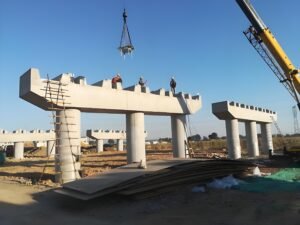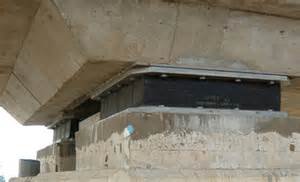Bridges are awe-inspiring structures that connect people and places across vast distances. But what most people don’t realize is the critical role played by a seemingly simple component – the bridge bearing. This article delves into the world of bridge bearings, exploring their functions, different types, and even considerations for their replacement.
The Silent Workhorses: What are Bridge Bearings?
Bridge bearings are the vital link between the upper structure (bridge deck) and the lower structure (substructure) of a bridge. Located at the interface between the bridge and the supporting pad, they serve as the crucial force transmission device. They play a silent yet essential role in ensuring the bridge’s stability and longevity. Broadly, there are two main types of bridge bearings: fixed and movable. Fixed bearings allow for minimal movement, while movable bearings accommodate thermal expansion, contraction, and other movements that occur naturally in bridges.
The Backbone of a Bridge: Functions of Bridge Bearings
Bridge bearings perform two primary functions:
- Safe Load Transfer: They safely transfer all the loads acting on the bridge – its own weight, traffic loads, wind loads, and even seismic loads – from the superstructure to the substructure. This ensures the bridge can withstand all the forces it encounters without compromising its structural integrity.
- Accommodation of Movement: Bridges are not static structures. They experience both translational (movement in a straight line) and rotational movements due to various factors. Translational movements can be caused by creep (gradual deformation of materials over time), shrinkage (contraction of materials as they dry), and temperature variations. Rotational movements can occur due to uneven settlement of the foundation, traffic loads, and construction tolerances. Bridge bearings are designed to accommodate these movements, ensuring the bridge doesn’t experience undue stress or cracking.
The Strength Behind the Scenes: Construction of Bridge Bearings
Bridge bearings are typically made from steel, elastomeric materials (rubber-like compounds), or a combination of both. They are attached to the bridge superstructure using a steel base plate, which rests on a steel or masonry slab on the substructure. The base plate helps distribute the concentrated load from the bridge onto a larger area of the substructure, while the slab further distributes the load for the substructure to handle effectively. The base plate can be bolted, welded, or embedded with anchors into the steel or concrete superstructure, and the masonry panels are typically secured with anchor bolts to the substructure.
A Look at the Diverse Team: Types of Bridge Bearings
Bridge designers have a wide variety of bearings at their disposal to suit different bridge types, loads, and movement requirements. Here’s a glimpse into some of the most common bridge bearing types:
- Rocker and Pin Bearings: These bearings allow for rocking or tilting motion but resist horizontal movement.
- Sliding Bearings: These bearings permit movement in one or two horizontal directions due to a low-friction material between the bearing surfaces.
- Roller Bearings: Similar to sliding bearings, roller bearings allow horizontal movement but use rollers for lower friction.
- Curved Bearings: These bearings offer a combination of rotational and limited translational movement due to their curved design.
- Elastomeric Bearings: These are the most popular type today, made from layers of elastomeric material and steel plates. They offer flexibility for both vertical and horizontal movements.
- Disk Bearings: These bearings consist of a steel cylinder with a spherical sliding surface, allowing for multi-directional movement.
- Pot Bearings: These bearings resemble a pot with a spherical sliding surface, offering high load capacity and multi-directional movement.
Replacing the Pillars: Considerations for Bridge Bearing Replacement
Over time, bridge bearings can deteriorate due to wear, fatigue, or environmental factors. When this happens, they need to be replaced to ensure the continued safety and functionality of the bridge. Here are some essential considerations for bridge bearing replacement:
- Jacking Methods: Different jacking techniques are needed for various bridge types. Selecting the appropriate lifting points and controlling the jacking force and height are crucial to avoid damaging the bridge deck or ancillary structures.
- Accounting for Beam Variations: The jacking force required can vary significantly between main beams and side beams due to weight differences. Careful monitoring of pressure and stroke during jacking is essential to prevent uneven lifting and potential damage to the bridge deck.
- Precise Control: Strict control over the jacking height is necessary to avoid excessive lifting that could damage the bridge deck and its components.
Conclusion
Bridge bearings, though often hidden from view, are the unsung heroes of bridges. They play a critical role in ensuring the bridge’s stability, longevity, and ability to accommodate natural movements. By understanding their functions, different types, and even replacement considerations, we gain a deeper appreciation for these vital components that keep our bridges standing strong.
Summary
Bridge bearings, the hidden guardians of our bridges, play a crucial role in their stability, longevity, and functionality. They safely transfer loads and accommodate movements, ensuring the smooth operation of these vital structures. From understanding their diverse types to the intricacies of their replacement, we gain a deeper appreciation for these unsung heroes of infrastructure.
FAQ
What are bridge bearings?
Bridge bearings are the vital components that connect the upper structure (bridge deck) to the lower structure (substructure) of a bridge. They safely transfer loads and accommodate movements, ensuring the bridge’s stability and longevity.
What are the main functions of bridge bearings?
- Safe Load Transfer: Bridge bearings safely transfer all the loads acting on the bridge – its own weight, traffic loads, wind loads, and even seismic loads – from the superstructure to the substructure.
- Accommodation of Movement: Bridges experience both translational (movement in a straight line) and rotational movements due to various factors. Bridge bearings are designed to accommodate these movements, ensuring the bridge doesn’t experience undue stress or cracking.
What are the different types of bridge bearings?
Common bridge bearing types include:
- Rocker and Pin Bearings: Allow rocking or tilting motion but resist horizontal movement.
- Sliding Bearings: Permit movement in one or two horizontal directions due to a low-friction material between the bearing surfaces.
- Roller Bearings: Similar to sliding bearings, roller bearings allow horizontal movement but use rollers for lower friction.
- Curved Bearings: Offer a combination of rotational and limited translational movement due to their curved design.
- Elastomeric Bearings: The most popular type today, made from layers of elastomeric material and steel plates. They offer flexibility for both vertical and horizontal movements.
- Disk Bearings: Consist of a steel cylinder with a spherical sliding surface, allowing for multi-directional movement.
- Pot Bearings: Resemble a pot with a spherical sliding surface, offering high load capacity and multi-directional movement.
What are the considerations for bridge bearing replacement?
Essential considerations for bridge bearing replacement include:
- Jacking Methods: Appropriate lifting points, controlled jacking force, and precise height control are crucial to avoid damaging the bridge deck or ancillary structures.
- Accounting for Beam Variations: Jacking force requirements can vary between main beams and side beams. Careful monitoring of pressure and stroke during jacking is essential to prevent uneven lifting and potential damage to the bridge deck.
- Precise Control: Strict control over the jacking height is necessary to avoid excessive lifting that could damage the bridge deck and its components.
Bridge bearings, though often hidden from view, are the unsung heroes of bridges. They play a critical role in ensuring the bridge’s stability, longevity, and ability to accommodate natural movements. By understanding their functions, different types, and even replacement considerations, we gain a deeper appreciation for these vital components that keep our bridges standing strong.



